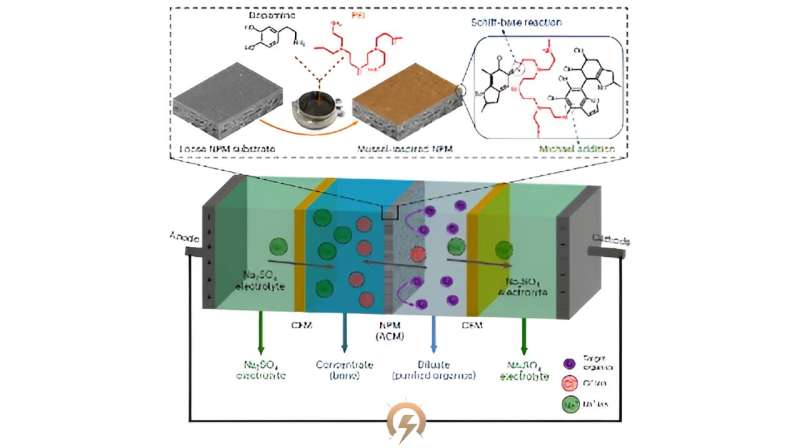This article has been reviewed according to Science X's editorial process and policies. Editors have highlighted the following attributes while ensuring the content's credibility:
fact-checked
peer-reviewed publication
trusted source
proofread
Mussel-inspired membrane can boost sustainability and add value to industrial wastewater treatment

Engineers have developed a new kind of membrane that separates chemicals within wastewater so effectively that they can be reused, presenting a new opportunity for industries to improve sustainability, while extracting valuable by-products and chemicals from wastewater.
Created for use in wastewater treatment, the thin-film composite nanoporous membrane known as a TFC NPM, exhibits an "unprecedented" capability to separate salts and other chemical components from water, and could lead to more sustainable treatment and management of water in a range of industries.
A research paper published today, August 3, in Nature Water details the membrane's performance and explains how its unique properties, aspects of which are inspired by mussels, could pave the way for more sustainable management of water within industries such as pharmaceuticals, oil and gas, textiles and food processing. The paper is authored by academics from the U.K.'s University of Bath alongside colleagues based in China, South Korea, Singapore, Australia and Belgium.
They say the membrane could replace current equivalents used in electrodialysis, a process used to treat water by transporting ions through membranes from one solution to another under an electrical current. Existing membranes are expensive and can achieve separation efficiencies of 90%–95%. The authors of the new work say the new TFC NPM can improve on this significantly, with efficiencies of more than 99%, while using less energy at a lower cost.
Dr. Ming Xie, lecturer in Chemical Engineering at the University of Bath and one of the paper's authors, says the membrane could lead to a shift in thinking around wastewater treatment. He says, "Traditionally, many industries have regarded the wastewater they create as a trade waste that is a necessary cost of business.
"Technologies such as the membrane we have created can help us take steps toward lowering carbon emissions by reducing the energy requirement of wastewater treatment, while finding ways to efficiently separate the components in it such as chemicals, salts, energy, biomass and nutrients, before reusing them as high-value by-products."
The researchers took inspiration from mussels when designing the coating on the membrane surface, which is made up of the polymer polyethyleneimine (PEI) and polydopamine (PDA), a compound which mussels excrete and use to stick to rocks or wood in wet conditions. The coating's stickiness makes the membrane highly selective, allowing water to pass through but blocking other compounds and organic materials. This multi-stage process results in improved filtration of the water, and a highly efficient, low-energy way to fractionate (or separate) chemicals individually.
Electrodialysis is a technology that has shown its adaptability to several applications, in this case, management of highly saline waste streams. In the electrodialysis process, electrical potential is used to drive the positive and negative ions of dissolved salts through separate semipermeable synthetic membrane.
During tests, the researchers used four antibiotics—ceftriaxone sodium, cefotaxime sodium, carbenicillin disodium and ampicillin sodium—to prove the PDA/PEI-coated membrane's electro-driven filtration performance. The membrane showed unprecedentedly high recovery efficiency in removing the antibiotics from saltwater solutions (water and NaCl sodium chloride)—with more than 99.3% desalination efficiency and more than 99.1% recovery of the antibiotics.
If incorporated in industrial wastewater treatment, the membrane has the capability to carry out highly effective electrodialytic fractionation (separation) of various organic/NaCl mixed solutions, more effectively than standard existing processes.
Co-author, Dr. Dong Han Seo from Department of Energy Engineering, Korea Institute of Energy Technology, said, "This work demonstrates the state of the art electrodialysis to address the grand challenge in the pharmaceutical industry to bio based wastewater treatment, to enable effective recovery of the high value chemicals while obtaining reusable water in the other end using a low energy consumption."
Dr. Jiuyang Lin from the Chinese Academy of Sciences, also a co-author, said, "This simple yet effective coating provides long term stability and guarantees low energy consumption regardless of the wastewater conditions. This is a breakthrough finding electrodialysis for wastewater treatment involving clever design of membrane, simulation and analysis."
The authors are exploring routes to commercialize the membrane.
More information: Jiuyang Lin et al, Shielding effect enables fast ion transfer through nanoporous membrane for highly energy-efficient electrodialysis, Nature Water (2023). DOI: 10.1038/s44221-023-00113-5. www.nature.com/articles/s44221-023-00113-5
Journal information: Nature Water
Provided by University of Bath





















